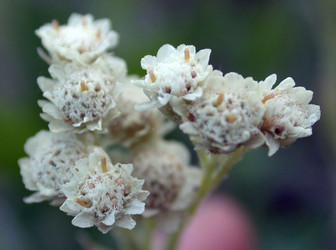Lakota name: caŋhlóġaŋ hu waŋjila– Means “weed with one stem”.
hituŋkala nakpála- Means “mouse ear”, because of the shape of the leaves.
poipiye- Name for any medicine good for swellings.
táhca nakapála- Means “deer ear” because of the shape of the leaves. Listen to Lakota Names: caŋhlóġaŋ hu waŋjila/hituŋkala nakpála/táhca nakpála/poipiye
Listen to Lakota Names: caŋhlóġaŋ hu waŋjila/hituŋkala nakpála/táhca nakpála/poipiye
Scientific name: Antennaria parvifolia
Common Names: littleleaf pussytoes, small-leaf pussytoes, Nuttall's pussytoes, common pussytoes, Rocky Mountain pussytoes, silver pussytoes, and pussytoes.
Lakota medicinal use: Good for swelling.
Description: Littleleaf pussytoes is a stoloniferous, mat-forming, perennial forb. Stems are 1.2 to 6.0 inches (3-15 cm) tall. Leaves are simple, alternate, and mostly basal. Cauline leaves are reduced upwards. The inflorescence is a large, closely aggregated cyme with two to six heads. The fruit is a small achene. This is a wildflower, it can grow in dry conditions, and it needs sun and partial shade. Inflorescence of 1-4 heads, sessile clustered; outer involucral bracts of pistillate heads with obtuse tips.



Antennaria parvifolia plants and close-up of flowers © Mary Ellen (Mel) Harte.
Flowering Period: White/Cream colored flowers in May.
U.S. Distribution: In Arizona, Colorado, Idaho, Minnesota, Montana, Nebraska, Nevada, New Mexico, North Dakota, South Dakota, Texas, Utah, Washington, and Wyoming.
South Dakota Distribution: Infrequent on dry plains over the state, more frequent w. May—June (Van Bruggen 1996).
Habitat: The plant is found on open plains and prairie, in open forests, dry meadows, and pastures, and along roadsides. It exhibits good growth on gentle slopes, but does not grow well on steep slopes. It grows best on loam-, clayey loam-, and clay-textured soils. Growth is poor on gravel, sand, and dense clay.
Existing or Potential Threats: Possible threats are grazing, timber harvest, conversion to agricultural or residential development, recreational activities, and road maintenance and construction.
Comments: This plant is a larval host for the painted lady butterfly.



 Go to quick links
Go to quick search
Go to navigation for this section of the ToL site
Go to detailed links for the ToL site
Go to quick links
Go to quick search
Go to navigation for this section of the ToL site
Go to detailed links for the ToL site